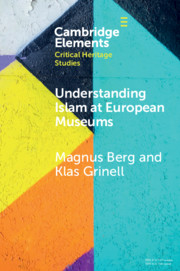Element contents
Understanding Islam at European Museums
Published online by Cambridge University Press: 12 July 2021
Summary
- Type
- Element
- Information
- Online ISBN: 9781108881623Publisher: Cambridge University PressPrint publication: 05 August 2021
References
References
Badisches Landesmuseum: www.landesmuseum.de/website/Deutsch.htm.
British Museum: www.britishmuseum.org/about_us/the_museums_story/general_history.aasp.
EGMUS (The European Group on Museum Statistics): www.egmus.eu/nc/en/statistics/complete_data.
Encyclopædia Iranica: www.iranicaonline.org/articles/indo-european-telegraph-department.
FHXB Friedrichshain-Kreuzberg Museum: www.fhxb-museum.de/index.php?id=1.
ICOM (International Council of Museums): http://icom.museum/the-vision/museum-definition.
ICOM Cultural Diversity Charter, 2010: http://inclusivemuseum.org/wp-content/uploads/2013/04/ICOM_Cultural_Diversity_Charter.pdf.
Index Islamicus: https://brill.com/view/db/iio.
Kulturkontakte. Leben in Europa: www.smb.museum/museen-und-einrichtungen/museen-dahlem/ausstellungen/detail.html?tx_smb_pi1%5Bexhibition%5D=38&cHash=23f17060db6fd5094f724aa6133e3b7a.
Museum für Islamische Kunst: www.smb.museum/en/museums-and-institutions/museum-fuer-islamische-kunst/about-the-collection.html.
Religionskundliche Sammlung: www.uni-marburg.de/relsamm.
Report of the Working Group on Cross Cultural Issues of the International Council of Museums (ICOM). Presented at the 89th session of the Executive Council of ICOM on December 1997: http://archives.icom.museum/diversity.html.
Runnymede Trust: www.runnymedetrust.org/uploads/Islamophobia%20Report%202018%20FINAL.pdf.
St Mungo Museum of Religious Life and Art: www.glasgowlife.org.uk/museums/st-mungos/pages/default.aspx.
Today’s Zaman: www.todayszaman.com/arts-culture_paris-louvre-museum-unveils-new-islamic-art-galleries_292939.html.
Victoria and Albert Museum: www.vam.ac.uk/content/articles/a/a-brief-history-of-the-museum.
Welten der Muslime: www.smb.museum/museen-und-einrichtungen/museen-dahlem/ausstellungen/detail.html?tx_smb_pi1%5Bexhibition%5D=35&cHash=d25088a6b52d04441708ba0981c97eb9.
- 8
- Cited by



